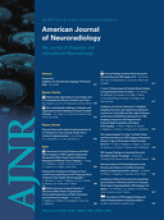Abstract
BACKGROUND AND PURPOSE: Percutaneous sacroplasty has recently gained attention as a potential treatment for sacral insufficiency fractures. We describe a readily identifiable fluoroscopic landmark that facilitates needle placement and validate this with virtual needle placement by using CT data and fluoroscopically guided treatment in 13 patients.
MATERIALS AND METHODS: From CTs of 100 consecutive patients, the optimal target zone for needle placement in the sacral ala was defined at the intersection of lines from each of the corners of the first sacral segment, which is readily identifiable on lateral fluoroscopy. We then measured the distance from that virtual target point to the anterior sacral cortex by using the CT data for 3 specific trajectories: 1) parallel to the L5-S1 disk, 2) axial with respect to the patient, and 3) along the long axis of the sacrum. Case records of 13 consecutive patients treated by using this technique were also reviewed.
RESULTS: The mean distances for the 3 trajectories were 11.3 mm, 11.2 mm, and 12.8 mm, respectively. Needle placement would have been outside the anterior sacral cortex in 3 patients. Review of preprocedure imaging easily identified this potential breach. During treatment, needle placement by using the landmark was successful in all patients, and there were no complications.
CONCLUSIONS: A safe target for sacroplasty needle placement in the superolateral sacral ala can be defined by using the intersection of lines drawn from the corners of the first sacral segment. We validated this landmark by using it for treatment in 13 patients. Further studies evaluating clinical outcomes following sacroplasty will be necessary.
- Copyright © American Society of Neuroradiology












